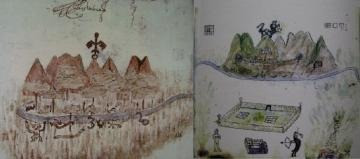Copy Link
Add to Bookmark
Report
OtherRealms Issue 25 Part 04

Electronic OtherRealms #25
Summer/Fall, 1989
Part 4 of 17
Copyright 1989 by Chuq Von Rospach
All Rights Reserved
OtherRealms may not be reproduced without permission from Chuq Von Rospach.
Permission is given to electronically distribute this
issue only if all copyrights, author credits and return
addresses remain intact. No article may be reprinted or re-used
without permission of the author.
From Beyond the Edge
Reviews by our readers (Part 1, continued)
Shadow Games [***]
Glen Cook
Tor $3.95 311pg.
While this book is the start of a new series about the Black Company,
there are many references to past events and people. This is especially
true in the second half of the book. As a result, anyone who has not
read the first series will suffer from some confusion.
When the first series ended, the Company was down to seven people and
Croaker expressed the intention to return the company annals to
Khatovar, where the Company originated. The first half of the book is
about the journey south. Unknown to the Company the Shadow Lords stand
between the Company and their final destination. However the Shadow
Lords know about the company and are trying to stop them. The reason
for the Shadow Lords' enmity become clear in the second half.
The ending is a cliffhanger. The Company suffers a major defeat at the
hands of the Shadow Lords. Croaker is captured. Lady may or may not be
dead. No mysteries are solved. No conflicts are resolved. The whole
book is basically the first installment of a very long serial. This is
a well written book although not up the level of Cook's best work.
-- Danny Low
Shadow Guests
Joan Aiken
Dell 1986, $2.95
This is a children's book about ghosts and responsibility. Cosmo, whose
mother and brother disappeared in Australia, returns to England, while
his father sells off the remains of their life down under. Cosmo lives
with his aunt on weekends in the family's ancestral home and discovers
that there is a curse on his family in which the eldest son of each
generation is killed in battle with his mother dying of sorrow
afterwards. The shadow guests of the title are the ghosts of previous
sons from history. Cosmo works to bring the curse to an end during the
story. I enjoy the individuality of Joan Aiken's work
-- Joyce Scrivner
The Singing [***-]
Theron Raines
Atlantic Monthly, 1988, 163 pp., $12.95, 0-87113-177-3.
The Singing is so full of cliches and stereotypes that you'd expect it
to be a complete disaster, but it is saved to an extent by the smooth
style of its literary-agent author. Atlantic Monthly Press doesn't
publish much science fiction, but when it does it's typically by
"mainstream" writers like Theron Raines who are apparently unaware of
the vast SF world Out There. Thus they tend to reinvent the rocket --
or in this case, the Man from Mars.
The Man in The Singing is a Martian called 4-S-T, who arrives in a UFO
with several co-conspirators bent on finding and mating with Earth
women in a last ditch effort to save the dying Martian race. 4-S-T
meets a girl named Mary Alice after his spacecraft crashes onto the
roof of the Guggenheim Museum in New York, but it's no accident, for
each of the Martian agents have their future loves already targeted,
and with the vastly superior Martian mental powers at their disposal,
it doesn't take long to get things going. Soon Forrest, as Mary Alice
calls him, is working in her office and sleeping in her bed -- and
fathering her child as the Martian plan to reinvigorate both races
moves forward.
Alas, as the time approaches for Forrest to abandon Mary Alice and
return to Mars, it becomes clear that the attempt to merge the two
races will fail and that there will be no revival of the Martians or
improvement of the Earthians after all. But even though his mission is
a failure, Forrest ends on an upbeat note, a poetic and mystical
stream- of-consciousness interchange with his Martian brothers -- an
interplanetary slam-bam-thank-you-mam, to put it crudely. Yep, them
Martian devils skip out on child support and Everything, but redeem
themselves by listening to and appreciating The Singing of Ole Mother
Earth on their way out.
The Singing is subtitled "A Fable About What Makes Us Human", and if
you can see it in that light you'll probably enjoy the book. Veteran SF
readers, however, will probably have trouble understanding why anyone
would want to read such soft core speculative fiction at all when
there's all that Good Stuff out there still waiting to be read. Be
warned -- The Singing is pretty thin stuff.
-- Neal Wilgus
Space Mail
Isaac Asimov, Martin H. Greenberg & Charles G. Waugh
Fawcett, 1982, $2.50
Another anthology of stories by classic writers. The diaries area holds
excerpts by Mark Twain (in a biblical tradition), Arsen Darnay
(meditation on nuclear power), Will Stanton (on animal intelligence),
John Collier (living away from modern life), Joan Vinge (mortality and
advancement), and Algis Budrys (advancement and the military.) Memos
section holds work by Walter Jon Williams (politics and society),
Anthony Boucher (alien views), R.A. Lafferty (education from biased
view), Gerald Jonas (growing up and parents), and Arthur Clarke (travel
and invasion). The letters section bears up under Sharon Webb (alien
medicine and romance), Paul J. Nahin (military secrets), Al Sarrantonio
(controlling children), Barry N. Malzberg (writing and publishing),
John Sladek (revolving history), Murray Leinster (curing madness), L.
Sprague de Camp (historical view) and John Campbell (hope and man). A
good selection from new work (and writers) to old stables.
-- Joyce Scrivner
Starfarers [****]
Vonda N. McIntyre
Ace, 3.95, 0-441-78053-9
I've just finished reading this book, and it's one of the few books
that I simply could not put down. The first third of the book is taken
up in setting up personal relationships. Normally this would irritate
me to no end. I like books that get moving rapidly, but in this case,
the relationships were interesting of themselves! The ideas behind them
were fascinating. When the action did start, it was extremely well
paced, and didn't appear to sag except when the characters themselves
couldn't seem to find the right thing to do.
Unlike quite a few recent books, I found that I could not figure out
what was going to happen next. Though the major climax occurs several
pages before the end of the book, the ending is excellent. It leaves no
dangling threads, but the future is left wide open and exciting! I
would recommend this book to anyone who enjoys science fiction.
-- Edwin Wiles
String in the Harp
Nancy Bond
Puffin Newbery Library 1976, $5.95
Books for children, though ignored by many readers, seem to me to have
several things which I enjoy: they have clear, clean plots with
characters with integrity (though the characters have no overt sex
life, they can be as convoluted as any human) and the major problem(s)
have resolutions, though not always happy. Newbery and Caldecott
winners in particular tend to be well-written and pleasant to read. So
I do. This book is no exception. The story is about a family with three
children (two girls and a boy (in the middle)) whose problems include
the fact that their beloved mother died shortly before Christmas, and
the father and two youngest siblings moved to Wales for a year for his
can do research. The living situation in Wales is foreign and difficult
for all of them, the boy in particular. The oldest child, who was
finishing school in America arrives for Christmas and stays for the
rest of the year learning to organize the family as her mother might
have done. The boy Peter finds an ancient harp key (which belonged to
Taliesin from the Mabinogion legend) and through the mechanism of the
key, history and the Welsh lifestyle bring the family to several
resolutions. The legends retold are not those most Americans recognize,
and the division in the family is believable as are the characters of
several Welsh who befriend them.
-- Joyce Scrivner
Svaha [***+]
Charles de Lint
Ace, 1989, $3.50
I'd known Charles de Lint as an author of contemporary fantasy, but I'd
seen Svaha reviewed as cyberpunk. It is.
The Native Americans have developed advanced technology and retreated
in to sealed Enclaves, while the rest of the world has gone to hell.
Life isn't so bad in the megaplexes (especially if you're pure
Japanese), but it's a different story in the squats, especially for the
little people like Lisa Bone, courier, and Phillip Yip, security
officer for Ho Anzen, who finds his job is full of ethical dilemmas.
An Enclave flier crashes, and Gahzee is sent out to recover its chip.
Needless, everyone else is after this item, too, from the yaks (yakuza
clans), to the triads, to Ininzi/Bell Northern, though who is working
for who isn't always clear.
De Lint manages to combine Gahzee's trip to a gritty cyberpunk city
(full of interesting details) with his visits to Dreamtime. He uses at
least 5 different languages for added color. And he provides the
insight as to why someone would replace perfectly good parts of their
own body.
I found one assumption of the background hard to believe, but enjoyed
both the setting and the story.
-- David Dunham
Swimmers Beneath The Bright [***-]
M. Coleman Easton
Questar 1987 $2.95 US 236 pp 0-445-20456-7
Mera Magus, the cyborged last guardian of Safehold, has slept in her
orbital station for eight thousand years, while the water-adapted
people of the colony world have gone their own way unhindered by
technology. Now, however, Mera Magus has been revived by the ancient
machinery, for the immemorial enemy, Spore, poses a new threat. The
sea-change, bred into the semi-aquatic folk of Safehold through
countless generations, may be humankind's last hope -- if only the
ancient and dying "god" from the sky can teach them how to activate and
use it.
This is by no means a bad book. It held my attention and though after
about 100 pages I had my fill of local color, and began wishing the
author would simply get on with it. There are also some hazy areas; the
entire mechanism of the gleaners and their relationship to the "god-
metal" is simply taken for granted, never explained. (Perhaps this
would be obvious to a metallurgist; it wasn't so to me.) Swimmers
reminded me slightly of Vinge's Snow Queen on a smaller scale. I would
consider reading another book by this author.
-- David M. Shea
A Talent for War [****]
Jack McDevitt
Ace $3.95 310pg.
Christopher Sim was the Hero of the Resistance. His death after his
betrayal by his best friend Talino united the human worlds against the
invading Ashiyyurs. However the details of the betrayal and death are
clouded by mystery as almost all the main participants died within
months of that fateful event. Two hundred years later, the death of
Alex Benedict's uncle thrusts him into a search for the solution to
what really happened to Sim.
Benedict is drawn in almost against his will. He starts out with a
handicap. Some one does not want him to continue his uncle's research
into the matter. A key document is stolen and Benedict must attempt to
recreate his uncle's research.
The mystery is very well constructed. All the denouements are
foreshadowed by hints so the reader can figure them out beforehand. The
solutions are sensible and sometimes even ingenious. The solutions are
easy to figure out since McDevitt is more interested in developing the
story than challenging the reader.
The background universe has a feeling of depth that is often lacking in
other books. The characters are very well developed. It is the
characters, not the mystery, that is the focus of the story. The
characters are complex and often irrational just like real people. The
solution to the mystery is ultimately based on the frailty of even the
strongest person.
The basic idea of the Sim story has been used before by other SF
writers. McDevitt has managed to come up with only a minor variation on
the story. As told by McDevitt, the story is a dramatic tale of tragedy
and redemption.
-- Danny Low
Tales from the Spaceport Bar [***]
George Scithers & Darrell Schweitzer
Avon, 1987, $3.50, 235pp.
Callahan's Place and the White Hart aren't the only bars with unusual
regulars and tellers of unbelievable tales. This short story collection
includes famous and not-so-famous tales set in and about bars of every
dimension, 22 in all (including a limerick). Most of the stories keep
to SF but a few stray into fantasy, though the editors decided to leave
out the sword and sorcery taverns -- there are probably enough of those
for an entire collection of their own. Many well known authors are
represented here -- Niven, Kuttner, Aximov, Clarke, Zelazny,
Silverberg. My favorites: "What Goes Up" by Arthur C. Clarke, a tale
about a real anti-gravity device; "One for the Road" by Gardner Dozois,
questions asked in a bar; "Strategy at the Billiards Club" by Lord
Dunsany, a cautionary tale from 1948 on the dangers of atomic weapons;
"They Loved Me in Utica" by Avram Davidson, a down-on-his-luck bar
entertainer is the same in every age, giving this story a quite
surprising ending.
-- Mary Anne Espenshade
Taltos [****]
Steven Brust
Ace, 1988, $2.95, 181pp.
A story set early in the career of Vlad Taltos, assassin -- the whole
book is flashbacks. Each chapter begins with Vlad at work on a spell
that actually concludes the story, then alternates scenes of his
journey through the Paths of the Dead and anecdotes from his childhood
and early career -- his studies of witchcraft, his training in weapons,
the first time he kills, the first time he's paid to kill and the first
time he kills with a Morganti weapon. Lots of light, comic touches,
particularly in Vlad's comments to his jhereg familiar, Loiosh (watch
for a Blake's Seven quote and a reference to the computer game "Adventure").
Sequel to Jhereg, Yendi and Teckla, it takes place before all of them
and could be read first. A must-read if you have the other three.
-- Mary Anne Espenshade
The Thief of Bagdad [***]
Achmed Abdullah
Donning/Starblaze, 1987, $12.95, 120pp.
The first volume in the Starblaze Classics series of illustrated novels
is an Arabian fantasy originally written in 1924 and long out of
print. It is the novelization of the silent film of the same name and
one of the earliest movie novelizations written. The prose style is
like nothing you'll find now -- every sentence in a paragraph long,
adjectives and adverbs travel in packs, never in less than groups of 10 --
flowery only just begins to describe it. But the story is great fun,
fast paced with rambling breaks into the "historical" sources. For
those interested in the fantasy of an earlier and decidedly different
time and place.
-- Mary Anne Espenshade
To Sail Beyond the Sunset
Robert A. Heinlein
It is the 'history' of Lazarus Long's mother, Maureen, and how she grew
up from the late 1800s into the 2100s. All the women are beautiful,
their breasts don't ever droop (unless they want them to), they succumb
to the scent of desire of the male anatomy (only hypocrisy drives them
away, and no science fiction reader has hypocrisy, correct?) Some of
the men get snotty over not having enough women in the ways they want
them, but it is always brought on by the petty jealousy of a not-so
beautiful woman (ie. Maureen divorced Lazarus' father due to another
woman's desire for possession) or female lack of control (the two
youngest children of Maureen and her first husband are emotionally
twisted by the girl's absolute passion in bed for her brother, or if
she can't get her brother, anything in pants.) This is another long
'talky' novel in which the narrator (ie. Maureen) tells the story for
chapter upon chapter. Only in the first couple chapters and the last
couple chapters do the framing incidents of time travel and Maureen's
lust for her father win out. My suggestion would be go buy a selection
of the Heinlein juveniles. Nothing he has written in the past ten years
can better those. This is a male fantasy as the cardboard women just
fall in bed with them.
-- Joyce Scrivner
Under the Mountain
Maurice Gee
Oxford University, 1979, $9.95
This is another children's book by this New Zealand author. The story
concerns red-haired twins whose stay with relatives has legend woven
into it. Theo and Rachel spend the book solving the problem. The
setting is Auckland, which has a slight cultural difference to the US
reader, and adds to the feeling of eerieness. I thought the children
were slightly flat (like Coke that has grown lukewarm) as major
characters, but the situation and their struggles are emotionally
satisfying.
-- Joyce Scrivner
Walkabout Woman [****]
Michaela Roessner
This is a novel based on the Australian Aborigine idea of the
Dreamtime, sort of a parallel reality to ours. It gives a feel for a
very alien perception of the universe, and does it well. Part 1 (the
first two- thirds of the book) describes the heroine's education about
the Dreamtime, and how she is brutally cut off from it. This is by far
the stronger section of the book, both because of the conflict of
cultures (Aborigine versus white) and the conflicts within the tribe.
Part 2 picks up the story a decade later, after Raba has been living in
the white's world. The conflicts still exist, but are not as
emotionally involving. Maybe the author overextended herself tackling
bigger and bigger themes, or maybe the supporting characters were just
less interesting. In spite of the somewhat weak ending, I do recommend
this book highly. It is one of the best evocations of an alien culture
I've read recently, and the culture really exists here on Earth.
-- Chuck Koelbel
Weaveworld
Clive Barker
Posideon, 1987, $24.95
This is being marketed both in the US and UK as the Clive Barker
blockbuster. The book that will change him to a best seller like
Stephen King. Well, I don't know how Stephen King got to be a
blockbuster, but I doubt if this does it for Barker. It is a good,
involving book, though. It is a long (584 pages), interwoven story
about a fantastic land which resides along side the 'normal' everyday
life you and I know so well (i.e. work, eat, work, eat, weekends off
and back to work). The land had been protected from destruction by
placing it into the rug and now enemies are coming close again.
Suzanna, the granddaughter of the last guardian, fights hard to protect
the land with Calhoun, who had seen and revealed the land by accident.
They attempt to defend it from Immacolata and her stooge, Shadwell.
Recommended as a well-constructed fantasy. For those who like horror,
check out Barker's Books of Blood.
-- Joyce Scrivner
Who's Afraid of Beowulf? [***]
Tom Holt
St. Martin's, 206 pg.
Tom Holt turns around Arthur C. Clarke's saying that any sufficiently
advanced technology looks like magic. In this book, it takes a very
advanced technology to duplicate the effects of magic. Hildy
Frederiksen is an archaeologist who stumbles upon the find of her
dreams, an intact Viking burial ship. However the ship is intact
because it and its crew have been preserved by a magic spell. The spell
is intended to be lifted when the Evil Sorcerer is once again ready to
take over the world. That time is now.
Willy-nilly, Hildy is caught up in the quest of 1200-year-old Vikings
to find their ancient enemy who is quite real and running a worldwide
conglomerate. The Vikings are not as helpless as Hildy first thinks.
They know all about elevators and television. In fact, the magical
versions they had were much better. Naturally they all wear enchanted
armor which is totally bullet proof and wield magical swords that can
slice through composite tank armor like it was so much cardboard.
The book is very well done and is very humorous. Holt walks the line
between satire and caricature and succeeds. His Vikings are simple but
not simplistic. They are not the brutish killers of a Harry Harrison or
Keith Laumer parody. Holt does some contrasting between Hildy's modern
sensitivity and the Vikings casual attitude towards killing. Their
leader, Hrolf Ketilsson, is an intelligent leader who quickly adapts to
the modern world. In summary, a well-done humorous story.
-- Danny Low
With a Tangled Skein
Piers Anthony
Del Rey, 1985, $3.95
This is the third of the unique Incarnations of Immortality series.
People assume the guise of an incarnation to achieve an end they
desire. The first two books concern death and time, this one is about
fate. Each book is separate within itself, yet reveals aspects of a
more complex story. Niobe takes on an aspect of fate when her lover is
shot in a plot to kill her by Satan. She spends the remainder of the
novel opposing other machinations against herself and her descendants.
The resolution depends upon a test very much in the classical
question-of-the-Sphinx tradition.
-- Joyce Scrivner
The Wizard in the Tree
Lloyd Alexander
Dell, 1975, $3.25
Lloyd Alexander is best known for his Prydain chronicle based on Welsh
mythology, but I also enjoy his other children's books. This is the
story of Mallory, a kitchen maid, who finds the wizard Arbican in an
oak tree. She attempts to help him in his journey to Vale Innis, Land
of Heart's Desire and is opposed by the greedy town squire and his
henchmen. This is another of the charming-young-hero(ine) and helpful-
older-wise(man) stories with morals and manners and pleasant writing,
it is easy to read and forget.
-- Joyce Scrivner
Wizards
Isaac Asimov, Martin H. Greenberg & Charles Waugh
Signet, 1983, $3.50
An anthology of stories by science fiction's master writers. Jack Vance
"Mazirain The Magician," L. Sprague de Camp's "The Eye of Tandyla," Ron
Goulart's "Please Stand By" (in shades of humor) and Robert Howard "The
People of the Black Circle" tell stories in their unique styles. Larry
Niven's "What Good is a Glass Dagger" has long since become an oft-
reprinted classic. Greg Bear has "The White Horse Child" which talks of
one type of daily magic for the modern world. Ursula Le Guin's "Semley's
Necklace" shows how technology can appear as magic to the less technical
society. John Jake's "And the Monsters Walk" is now a rare item to be
in print. Theodore Cogswell's "Wall Around the World" revels in human
accomplishment. Manly Wade Wellman's "The Seeker in the Forest" talks
about human weakness. A good collection of interesting work.
-- Joyce Scrivner
Wolf Moon [***-]
Charles de Lint
Signet 1988 252 pp, $3.50 0-451-15487-8
Fleeing a predatory magician/harper and his magical monster, Kern the
shapechanger finds shelter at the Inn of the Yellow Tinker. Among the
staff of the inn Kern finds acceptance, friendship, and eventually
love. But to those pursuing him, Kern's death is not enough: they will
twist all his happiness into tortured betrayal before striking the
fatal blow, if they can. Will Kern's wolf powers and the loyalty of his
friends stand up against evil magic?
Here we have standard plot number 3-B, were-creature as inadvertent
hero (see Andre Norton's Year Of The Unicorn, Clifford Simak's The
Werewolf Principle among others). The setting is a standard
pseudomedieval world. The writing is graceful but overdone, carefully
explaining each minutest point, as if the reader cannot be trusted to
figure out anything on his own. The strength of the book lies in its
characters, who are pretty much standard issue fantasy characters, but
are mostly fleshed out well enough to be plausible as people. Wolf Moon
is, as diverting entertainment, a perfectly good read, though I would
have liked it better if it had a little more faith in the reader.
-- David M. Shea
------ End ------




















